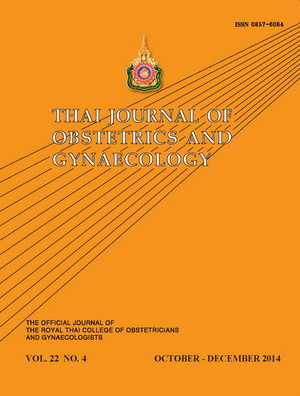Intrapartum Sonographic Measurement of Amniotic Fluid Volume for Prediction of Poor Fetal Outcomes in Low Risk Pregnancy
Main Article Content
Abstract
Objective: To determine the diagnostic value of intrapartum amniotic fluid volume, with single deepest
pocket (SDP) technique, for prediction of poor fetal outcomes in low risk pregnancy.
Materials and Methods: A cross-sectional study was conducted on 454 low risk singleton term pregnancies who delivered from April 2012–August 2012 at Ramathibodi Hospital. Ultrasonography estimated SDP was performed as an admission test and then continuous intrapartum electronic fetal monitoring (EFM) was done. Oligohydramnios was defined as a SDP ≤ 2.0 cm. The criteria for diagnosis of poor fetal outcomes were Apgar score at 5 minute ≤ 7, meconium stained amniotic fluid, abnormal EFM and neonatal intensive care unit (NICU) admission.
Results: A total 454 low risk singleton pregnancies was enrolled. Thirty eight cases (8.4%) were diagnosed as oligohydramnios by SDP technique and 19 cases of these had poor fetal outcomes. The sensitivity, specificity, negative predictive value (NPV) and positive predictive value (PPV) of SDP ≤ 2.0 cm for prediction of poor fetal outcomes were 20.9%, 94.8%, 82.7%, and 50.0%, respectively. After subgroup analysis, the sensitivity and specificity of oligohydramnios for prediction of meconium stained amniotic fluid was 25.4%, 94.2% and abnormal EFM was 25.0%, 92.9%, respectively. The relative risk of oligohydramnios with meconium stained amniotic fluid
and abnormal EFM were 3.7 (95% CI; 2.3, 6.0) and 3.6 (95%CI; 1.7, 7.5), respectively. However, the significance of low Apgar score at 5 minute and NICU admission could not be evaluated due to low incidence.
Conclusion: The intrapartum assessment of oligohydramnios by SDP ≤ 2.0 cm had high specificity for prediction of poor fetal outcomes and also was associated with increased risk of meconium stained amniotic fluid and abnormal EFM.


